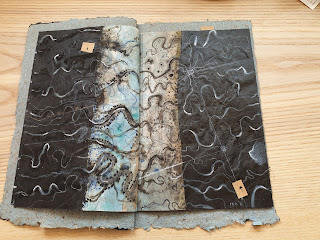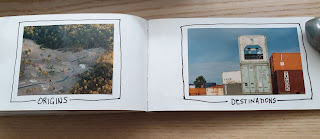Zines are a great way for artists to give away a small piece of their artwork or to sell cheaply.
In 2012 I made my first zines, a series of two based on my love of art history.
The first was called Guess Who's coming to Dinner?
I started looking for an image of a painting of the Last Supper. I found one painted as an altar frontal (c.1230) for a church in Soriguerola, Spain and as far as I know the artist is unknown. It is now in the Museu Nacional d'Art Catalunya in Barcelona.
Its composition was perfect and would suit being presented on a long page folded into a concertina. I made a line drawing of the composition in ink onto offcuts of Fabriano HP paper.
I found images of twelve male artists that I like who also made an artwork which contained something relating to food.
The heads of the artists and a small detail of food from their artwork were copied and pasted onto the drawing.
I then printed an edition of 50.
The artists included were from left to right - Brett Whiteley, F.T. Marinetti, Paul Klee, Paul Cezanne, Andy Warhol, Pablo Picasso, Salvador Dali, Giorgio de Chirico, Jasper Johns, Vincent Van Gogh, William Robinson, Henri Matisse.The aim was to guess the names of the artists from the clues.
I made a little insert to be included with the zine which contained the names of all the artists.
A number of both zines went down to Hand Held Gallery in Melbourne which exhibited artists books and zines. I was pleasantly surprised to hear that one of the zines, Guess who's coming to Dinner was purchased from Hand Held Gallery by the University of Melbourne Library Special Collections.
I made the second zine in the series Guess who's not Cooking Dinner? using the same method. I searched for another painting of The Last Supper and came up with a painting by Duccio.

Duccio's Last Supper (1308-1311) was commissioned by Siena Cathedral in 1308 and was completed in 1311. The double sided altarpiece is now in the Cathedral's museum. It was a perfect composition for my line drawing and I used the same method of photocopying the heads of the artists and placing a small detail from their artwork on the table.
This one was to be of female artists and the issue of equality. Like the male artists these women would not have had time (or perhaps the desire) to stop work and cook dinner.
The artists I included here are from left to right back row -
Berthe Morisot, Yayoi Kusama, Georgia O’Keeffe, Yoko Ono, Tracey Emin,
Margaret Olley, Margaret Preston, Judy Chicago
From left to right front row - Sonia Delaunay, Frida Kahlo, Artemisia Gentileschi,
Fiona Hall, Kathe Kollwitz
I made an edition of 50 copies again and also included a little insert with the names of the artists.
I enjoyed making these so much it could be fun to make some more zines now I've more time to play.
Part 2 will be about some zines I bought from Hand Held Gallery not long before it closed down.
























































